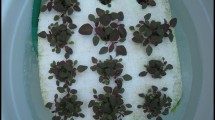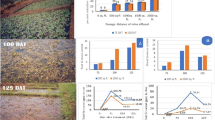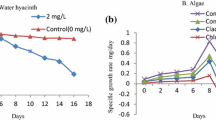Abstract
Contamination of water resources by emerging contaminants, radionuclides, heavy metals and nitrate is a critical problem that adversely affects the biotope. Constructed wetlands, as one of the least energy consuming methods have become an interesting option for wastewater treatment. In this study, terrestrial plants were used for phytoremediation of important pollutants from waste water. Therefore, uptake rates of cesium, metformin, arsenic and nitrate in hydroponic mesocosem constructed wetland were studied. When initial Cs concentrations were 2.35, 7.90 and 19.75 mg l−1 in mesocosem constructed wetland, 89.36 ± 0.42, 88.56 ± 0.19 and 84.72 ± 0.15% of cesium were remediated by Amaranthus chlorostachys plants. In the same cesium concentrations in mesocosem constructed wetland, 18.43 ± 2.76, 78.98 ± 0.25 and 89.35 ± 0.25% cesium found to be remediated by Calendula alata plants. When exposed to 20 and 50 mg l−1 metformin solutions 63 ± 14 and 58.4 ± 8.60% metformin were remediated by Amaranthus retroflexus plants. When exposed to 0.3 mg l−1 sodium arsenate solution, 85.5 and 93.1% of arsenic were remediated after 14 and 21 days by Vetiveria zizanioides. In the case that initial concentrations of nitrate in hydroponic mesocosem constructed wetland were 32.7, 40.08 and 47.37 mg l−1, 40.27, 26.64 and 70.02% of nitrate were removed, respectively, after 14 days.






Similar content being viewed by others
References
Amaral CBD, Nóbrega JA, Nogueira ARA (2013) Sample preparation for arsenic speciation in terrestrial plants—a review. Talanta 115:291–299
Borghei M, Arjmandi R, Moogouei R (2011) Potential of Calendula alata for phytoremediation of stable cesium and lead from solutions. Environ Monit Assess 181:63–68
Brauer N, Maynard JJ, Dahlgren RA, O’Geen A (2015) Fate of nitrate in seepage from a restored wetland receiving agricultural tail water. Ecol Eng 81:207–217
Carlsson C, Johansson A-K, Alvan G, Bergman K, Kühler T (2006) Are pharmaceuticals potent environmental pollutants? Part I: environmental risk assessments of selected active pharmaceutical ingredients. Sci Total Environ 364:67–87
Cook LL, Inouye RS, Mc Gonigle TP, White GJ (2007) The distribution of stable cesium in soils and plants of the eastern Snake River Plain in southern Idaho. J Arid Environ 6:40–64
Corcoran J, Winter MJ, Tyler CR (2010) Pharmaceuticals in the aquatic environment: a critical review of the evidence for health effects in fish. Crit Rev Toxicol 40:287–304
Dahmani-Muller H, Van Oort F, Gelie B, Balabane M (2000) Strategies of heavy metal uptake by three plant species growing near a metal smelter. Environ Pollut 109(2):231–238
Eggen T, Lillo C (2012) Antidiabetic II drug metformin in plants: uptake and translocation to edible parts of cereals, oily seeds, beans, tomato, squash, carrots, and potatoes. J Agric Food Chem 60:6929–6935
Eggen T, Asp TN, Grave K, Hormazabal V (2011) Uptake and translocation of metformin, ciprofloxacin and narasin in forage- and crop plants. Chemosphere 85:26–33
Farré MI, Pérez S, Kantiani L, Barceló D (2008) Fate and toxicity of emerging pollutants, their metabolites and transformation products in the aquatic environment”. TrAC Trends Anal Chem 27:991–1007
Faure G (1998) Principles and applications of geochemistry. Prentice-Hall, Upper Saddle River
Favas PJC, João Pratas J, Prasad MNV (2012) Accumulation of arsenic by aquatic plants in large-scale field conditions: opportunities for phytoremediation and bioindication. Sci Total Environ 433:390–397
Fent K, Weston AA, Caminada D (2006) Ecotoxicology of human pharmaceuticals. Aquat Toxicol 76:122–159
Focazio MJ, Kolpin DW, Barnes KK, Furlong ET, Meyer MT, Zaugg SD (2008) A national reconnaissance for pharmaceuticals and other organic waste water contaminants in the United States—II untreated drinking water sources. Sci Total Environ 402:201–216
Gagné F, Blaise C, André C (2006) Occurrence of pharmaceutical products in a municipal effluent and toxicity to rainbow trout (Oncorhynchus mykiss) hepatocytes. Ecotoxicol Environ Saf 64:329–336
Gonzaga MIS, Gonzaga Santos JA, Ma LQ (2006) Arsenic phytoextraction and hyperaccumulation by fern species. Sci Agric 63:90–101
Hamilton T, Seagars D, Jokela T, Layton D (2008) 137Cs and 210Po in Pacific walrus and bearded seal from St. Lawrence Island, Alaska. Mar Pollut Bull 56:1158–1167
Jones OAH, Voulvoulis N, Lester JN (2001) Human pharmaceuticals in the aquatic environment a review. Environ Technol 22:1383–1394
Jones OAH, Voulvoulis N, Lester JN (2002) Aquatic environmental assessment of the top 25 English prescription pharmaceuticals. Water Res 36:5013–5022
Leguizamo MAO, Gómez WDF, Sarmiento MCG (2016) Native herbaceous plant species with potential use in phytoremediation of heavy metals, spotlight on wetlands—a review. Chemosphere (In Press, Corrected Proof, Available online 4 November 2016)
Maestri E, Marmiroli M, Visioli G, Marmiroli N (2010) Metal tolerance and hyperaccumulation: Costs and trade-offs between traits and environment. Environ Exp Bot 68:1–13
Mao X, Han FX, Shao X, Guo K, McComb J, Arslan Z, Zhang Z (2016) Electro-kinetic remediation coupled with phytoremediation to remove lead, arsenic and cesium from contaminated paddy soil. Ecotoxicol Environ Saf 125:16–24
Mitsch W (2012) What is ecological engineering? Ecol Eng 4:5–12
Mitsch WJ, Zhang L, Waletzko E, Bernal B (2014) Validation of the ecosystem services of created wetlands: two decades of plant succession, nutrient retention, and carbon sequestration in experimental riverine marshes. Ecol Eng 72:11–24
Moogouei R, Borghei M, Arjmandi R (2011) Phytoremediation of stable Cs from solutions by Calendula alata, Amaranthus chlorostachys and Chenopodium album. Ecotoxicol Environ Saf 74:2036–2039
Nakbanpote W, Meesungnoen O, Prasad MNV (2016) Chapter 9 – Potential of ornamental plants for phytoremediation of heavy metals and income generation. In: Prasad MNV (ed) Bioremediation and bioeconomy. pp 179–217
Niemuth NJ, Klaper RD (2015) Emerging wastewater contaminant metformin causes intersex and reduced fecundity in fish. Chemosphere 135:38–45
Pilon-Smits E (2005) Phytoremediation. Annu Rev Plant Biol 56:15–39
Pinder JE III, Hinton TG, Whicker FW (2006) Foliar uptake of cesium from the water column by aquatic macrophytes. Environ Radioact 85(1):23–47
Pipíška M, Lesný J, Hornik M, Augustín J (2004) Plant uptake of radiocesium from contaminated soil. Nukleonika 49(Suppl. 1):9–11
Pomati F, Castiglioni S, Zuccato E, Fanelli R, Vigetti D, Rossetti C (2006) Effects of a complex mixture of therapeutic drugs at environmental levels on human embryonic cells. Environ Sci Technol 40:2442–2447
Rezania S, Taib SM, Md Din M F, Aini Dahalan F, Kamyab H (2016) Comprehensive review on phytotechnology: heavy metals removal by diverse aquatic plants species from wastewater. J Hazard Mater 318:587–599
Roy M, Giri AK, Dutta S, Mukherjee P (2015) Integrated phytobial remediation for sustainable management of arsenic in soil and water. Environ Int 75:180–198
Salt DE, Smith RD, Raskin I (1998) Phytoremediation. Annu Rev Plant Physiol Plant Mol Biol 49:643–668
Santos LHMLM, Gros M, Rodriguez-Mozaz S, Delerue-Matos C, Pena A, Barceló D (2013) Contribution of hospital effluents to the load of pharmaceuticals in urban wastewaters: identification of ecologically relevant pharmaceuticals. Sci Total Environ 461–462:302–316
Saussereau E, Lacroix C, Guerbet M, Cellier D, Spiroux J, Goull JP (2013) Determination of levels of current drugs in hospital and urban wastewater. Bull Environ Contam Toxicol 91:171–176
Scherer M, Sacher F, Brauch H-J (2009) Occurrence of the antidiabetic drug metformin in sewage and surface waters in Germany. J Environ Monit 11:1608–1613
Singh S, Thorat V, Kaushik Raj CP, Eapen S, D’Souza SF (2009) Potential of Chromolaena odorata for phytoremediation of 137Cs from solutions and low level nuclear waste. J Hazard Mater 162:743–745
Singh R, Singh S, Parihar P, Singh VP, Prasad SM (2015) Arsenic contamination, consequences and remediation techniques: a review. Ecotoxicol Environ Saf 112:247–270
Smith AE, Lincoln RA, Paulu C, Simones TL, Caldwell KL, Backer LC (2016) Assessing arsenic exposure in households using bottled water or point-of-use treatment systems to mitigate well water contamination. Sci Total Environ 544:701–710
Sugiura Y, Kanasashi T, Ogata Y, Ozawa H, Takenaka C (2016) Radiocesium accumulation properties of Chengiopanax sciadophylloides. J Environ Radioact 151(Part 1):250–257
Sutton-Grier AE, Wright JP, Richardson CJ (2013) Different plant traits affect two pathways of riparian nitrogen removal in a restored freshwater wetland. Plant Soil 365(1–2):41–57. https://doi.org/10.1007/s11104-011-1113-3
Sytar O, Brestic M, Taran N, Zivcak M (2016) Plants used for biomonitoring and phytoremediation of trace elements in soil and water. In: Ahmad P (ed) Plant metal interaction. pp 361–384
Tajadod G, Moogouei R (2012) The study of anatomical changes under the influence of cesium uptake in Chenopodium album L. Ann Biol Res 3(3):1582–1592
Zhang Y, Geißen S-U, Gal C (2008) Carbamazepine and diclofenac: removal in wastewater treatment plants and occurrence in water bodies. Chemosphere 73:1151–1161
Zuccato E, Castiglioni S, Fanelli R, Reitano G, Bagnati R, Chiabrando C (2006) Pharmaceuticals in the environment in Italy: causes, occurrence, effects and control. Environ Sci Pollut Res 13:15–21
Acknowledgements
Special thanks to Professor Hassan Vafai for his invaluable assistance. Moreover thanks to MCPR for technical assistance.
Author information
Authors and Affiliations
Corresponding author
Rights and permissions
About this article
Cite this article
Moogouei, R. Use of Terrestrial Plants for Phytoremediation of Pollutants from Solutions. Iran J Sci Technol Trans Sci 42, 1753–1759 (2018). https://doi.org/10.1007/s40995-017-0356-0
Received:
Accepted:
Published:
Issue Date:
DOI: https://doi.org/10.1007/s40995-017-0356-0




